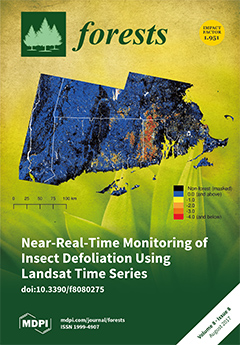Heterotrophic respiration (R
H) is a major flux of CO
2 from forest ecosystems and represents a large source of uncertainty in estimating net ecosystem productivity (NEP) using regional soil respiration (R
S) models. R
H from leaf litter (R
HL) may contribute greatly to annual R
H estimates, but its contribution may be misrepresented due to the logistical and technical challenges associated with chamber-based field measurements of R
HL. The purpose of this study was to evaluate the sensitivity of sources of R
H (mineral soil-derived heterotrophic respiration [R
HM] and leaf litter-derived heterotrophic respiration [R
HL]) of a loblolly pine plantation (Pinus taeda L.) to varying soil and litter water content over the course of a dry down event. Additionally, we investigated whether fertilization influenced R
HL and R
HM to understand how forest nutrient management may impact forest soil carbon (C) dynamics. R
HL was measured under dry conditions and at field capacity to evaluate water content controls on R
HL, determine the duration of increased CO
2 release following wetting, and evaluate the potential contribution to total R
H. We also measured R
HM inside collars that excluded plant roots and litter inputs, from field capacity until near-zero R
HM rates were attained. We found that R
HL was more sensitive to water content than R
HM, and increased linearly with increasing litter water content (R
2 = 0.89). The contribution of R
HL to R
H was greatest immediately following the wetting event, and decreased rapidly to near-zero rates between 3 and 10 days. R
HM also had a strong relationship with soil water content (R
2 = 0.62), but took between 200 and 233 days to attain near-zero R
HM rates. Fertilization had no effect on R
HM (
p = 0.657), but significantly suppressed R
HL rates after the wetting event (
p < 0.009). These results demonstrate that there is great temporal variability in both CO
2 released and the water content of differing sources of R
H, and forest fertilization may largely impact forest floor C stocks. This variability may not be captured reliably using conventional weekly to monthly chamber-based field sampling efforts and could lead to over- or underestimation of R
H. In the context of climate change, changes in the frequency and intensity of wetting and drying events will likely alter R
HL and its contribution to R
S. Separate consideration of R
H sources and controls, along with increased field sampling frequency using chamber-based methodology under a broader range of specific environmental conditions, are likely needed to reduce variability in R
H estimates and improve the accuracy of forest NEP predictions.
Full article





